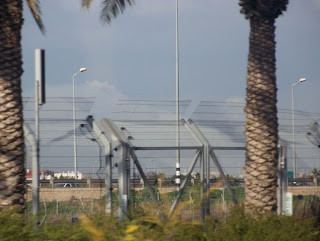Feb. 13, 2008
Today I thought it might be a nice change for you to view my photo album. Before we begin I will tell you that there seems to be several common themes emerging from this event. The first one is that the infrastructure is largely entrusted to the Israeli youth. The other is that each and every organization views their security in a concentric circles with a common center of the command and control center. They understand that its takes the right methods, the human element and technology to keep their facilities safe and secure.
The Youth
Putting youth in charge of arguably the most important component to an organizations ensured continuity is a concept quite foreign to the USA. The reason is simple, in Israel the youth, both men and women, are required to join the military. The result is a well respected and trustworthy member of society that is ready and willing to do whatever it takes to be a contributor.

Circles
These circles start beyond the outer boundary and move all the way into the facility. It takes into account each step a person must take and how they take it to get all the way to the center.
Here is the outer perimeter of the Ben-Gurion International Airport. Home to 2,300 security employees. They use a 5 meter outer fence with motion detection, fence detection and buried fence. There is a second layer of fencing with razor wire. PTZ cameras are placed every 300m and they are synced to an alarm that is slaved to the point of detection. There are over 10 million passengers and 380,000 tons of cargo that pass through here each year.

Here's the entrance to Ben Gurion, that's all you're going to see of it because they wouldn't let us bring in our cameras. They use an LPR (license plate recognition) system and check the plate against a national database. In addition they have over 700 cameras (some with infra-red night vision), UVS (under vehicle surveillance) and anti-missile systems. They are very proactive with technology.

Here is the main terminal. Outside and inside are posted armed undercover personnel. There is even a rumor that there are snipers placed inside the terminal just in case someone needs to be taken out. I cannot confirm whether this is true because I didn't see any.

They plan on spending an additional $20 million on emerging technologies over the next two years. Annually, it costs the airport $15-$20 million to maintain these high standards. Even though this is the safest airport in the world, to be 100% safe they claim they would have to completely stop operations. Not likely, but an interesting concept.
Our next stop was atop the Azrieli Center circular tower and mall. It is the tallest building in Tel Aviv. Here I am, on the helipad, over 52 stories in the air, right at the edge. In the background you can see the Mediterrerean Sea. The photo is facing north. The other two towers are in the shape of a triangle and square.

Each and every car is stopped and checked prior to entry into the facility. The same goes for all the people who enter the center. Once inside it is one of the safest places you can be. They have an average of 45,000 visitors to the mall each day. The Chief Security Officer says that they receive 5-6 bomb threats per day. Below is one of the check points entering the facility. Incase someone gets past they also have hydraulic lift barriers.

Our next and final stop of the day was the Tel Aviv Ha'Hagana train station. They have over 700,000 passengers per month. They have over 900Km of tracks and plan on adding cameras every 100m over the next 4 years. That is somewhere in the neighborhood of 2,500 new cameras each year.

Besides an outer perimeter check point they use sniffer dogs all day every day to find bombs hidden on the platform. Luckily none were found, except for a small demonstration.
Below is a sniffer dog that is used beyond the perimeter.

Tomorrow is the products showcase. You can expect a full blog with text, pictures and videos. Good night, stop by tomorrow.
No comments:
Post a Comment